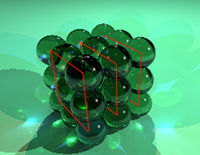MATHEMATICAL MODELS FOR DISLOCATIONS
Rome, December 13, 2007

MATHEMATICAL MODELS FOR DISLOCATIONSRome, December 13, 2007 |
 |
We study dislocation dynamics with a level set point of view. The model looks at the zero level set of the solution of a non local Hamilton Jacobi equation, as a dislocation in a plane of a crystal. I first present a convergent finite difference scheme for the corresponding level set formulation of the model. This type of approximation requires a high gradient to localize correctly the front, therefore (to avoid the use of reinitialization techniques) we have developed a new Fast Marching algorithm for eikonal equations with velocities changing sign. I will then present the new method applied to dislocations dynamics also showing some numerical simulations.
Homegenization of dislocation dynamics
N. Forcadel (ENSTA, Paris)
In this talk, we are interested in the collective behaviour of linear
defects in crystal called dislocations. We will study a simple model for
such a dynamic and we will present an homogenization result in its
simplest form. We will also give some qualitative properties of the
effective hamiltonian.
This is a joint work with C. Imbert and R. Monneau.
A line tension approximation for dislocations
A. Garroni (SAPIENZA, Univ. di Roma)
Dislocations are defects in crystals which are present on slip planes and
at a mesoscopic level can be approximated with line objects.
The energy associated to a dislocation on a given slip plane can be
described by a multi-phase field variational model recently introduced by
Koslowski and Ortiz. The underlying energy is a 2D vector phase-transition
functional, with a non local singular perturbation and a non linear
potential which vanishes on a lattice. We describe, by means of
Gamma-convergence, the mesoscopic limit of these functionals as the
lattice parameter goes to zero and we obtain, in the limit, an anisotropic
line tension energy.
The line tension energy density can be explicitly computed in the scalar
case (where the scalar phase describe the activation of one slip system in
the slip plane) and exhibits a one dimensional character (i.e. the optimal
profile is one dimensional), while in the vector case the optimal
transition can create oscillations and the line energy density is the result of an
relaxation process.
Atomically informed modeling of the microstructure evolution of nanocrystalline materials
A. Mattoni (SLACS, Univ. di Cagliari)
Molecular dynamics simulations represent a powerful tool to understand and
to model the microstructure evolution of advanced materials. The
transformation kinetics of a material is in most cases controlled by the
mobility of defects (such as point defects, dislocations or boundaries)
that, in turn, is the result of both atomic-scale details (chemical
bonding) and long-range effects (orientational, strain effects, mass
transport and many others).
Large scale molecular dynamics simulations by explicitly taking into
account the dynamics of a large number of atoms (routinely 105-106 atoms)
may effectively act as numerical experiments in order to validate
alternative, sometimes conflicting models of microstructure evolution.
We present examples related to nanocrystalline silicon systems that are of
great technological relevance, ranging from microelectronics to
photovoltaics.
Joint works with L. Colombo.
Mathematical modelling of dislocation dynamics
R. Monneau (CERMICS, ENPC, Marne La Vallé)
I will present an introduction to what are dislocations. I will explain in particular how we can do the modeling of dislocation dynamics and present briefly some recent results for different models.
A variational model for plasticity via homogenization of straight dislocations
M. Ponsiglione (SAPIENZA, Univ. di Roma)
In this talk we will present some result obtained in collaboration
with A. Garroni and G. Leoni, concerning the asymptotic
behavior of the elastic energy induced by dislocations in a crystal, as
the atomic scale tends to zero. Our analysis is performed
in dimension two, so that the dislocations are assumed to be straight.
In order to set up a variational formulation, we remove a disc of
radius comparable with the atomic distance around each dislocation, and
we minimize the linearized elastic energy in the remaining part of the
domain among all strains compatible with the given configuration of dislocations.
The Gamma-limit of such energies will be given by
the sum of two terms. The plastic term depends on the dislocation density
measure through a 1-homogeneous energy density. The elastic term is
quadratically dependent on the strain. The pre-factors of these two terms
depend on the asymptotic behavior (as the atomic scale tends to zero) of
the number of dislocations present in the crystal.